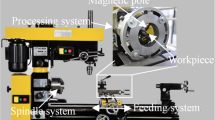Abstract
The Magnetic abrasive finishing (MAF) process is a surface finishing technique in which a magnetic field is used to control abrasive particles during surface finishing of a material. Because smooth surfaces are required for general use, the magnetic abrasive finishing process was developed for finishing surfaces. We studied the effect of CNT particles on the surface roughness of a workpiece. Magnesium alloy bars were used as the cylindrical workpiece and were finished using an MAF process at high workpiece revolution speeds of 1000, 5000, 10000 and 25000 rpm; diamond pastes with diameters of 0.5, 1, and 3 μm were used for comparison. The best value for surface roughness was equivalent to treatment at 0.02 μm when 0.01 g of CNT particles was mixed together with the unbonded magnetic abrasive at 25000 rpm for 20 seconds. CNT particles were applied to the finishing process to improve the surface roughness of the material, because they have many advantageous properties such as very high strength, light weight, elasticity, and high thermal and air stability. CNT particles are particularly effective for the improvement of Mg alloy bar surface roughness in the MAF process.
Similar content being viewed by others
References
S. Yoon, J. F. Tu, J. H. Lee, G. E. Yang, and S. D, Mun, Effect of the Magnetic Pole Arrangement on the Surface Roughness of STS 304 by Magnetic Abrasive Machining, International Journal of Precision Engineering and Manufacturing, 15 (7) (2014) 1275–1281.
V. K. Jain, P. Kumar, P. K. Behera, and S. C. Jayswal, Effect of working gap and circumferential speed on the performance of magnetic abrasive finishing process, 13 th International Conference on Wear of Materials, 250 (2001) 384–390.
I. T. Im, S. D. Mun, and S. M. Oh, Micro Machining of an STS 304 Bar by Magnetic Abrasive Finishing, Journal of Mechanical Science and Technology, 23 (7) (2009) 1982–1988.
G. W. Chang, B. H. Yan, and R. T. Hsu, Study on cylindrical magnetic abrasive finishing using unbonded magnetic abrasives, International Journal of Machine Tools and Manufacture, 42 (2002) 575–583.
S. Yin and T. Shinmura, Vertical vibration-assisted magnetic abrasive finishing and deburring for magnesium alloy, International Journal of Machine Tools & Manufacture, 44 (2004) 1297–1303.
S. Ijiima, Helical Microtubules of Graphitic Carbon, Nature, 354 (1991) 56–58.
S. R. Bakshi, D. Lahiri, and A. Agarwal, Carbon nanotube reinforced metal matrix composites–a review, Int. Mater. ev, 55 (1) (2010) 41–64.
R. H. Baughman, A. A. Zakhidov and W. A. de Heer, Carbon Nanotubes-the Route Toward Applications, Science, 297 (5582) (2002) 787–792.
M. F. Yu, O. Lourie, M. J. Dyer, K. Moloni, T. F. Kelly and R. S. Ruoff, Strength and Breaking Mechanism of Multiwalled Carbon Nanotubes Under Tensile Load, Science, 287 (5453) (2000) 637–640.
M. M. J. Treacy, T. W. Ebbesen and J. M. Gibson, Exceptionally High Young’s Modulus Observed for Individual Carbon Nanotubes, Nature, 381 (1996) 678–680.
B. Girma, S. S. Joshi, M. V. G. S. Raghuram and R. Balasubramaniam, An Experimental Analysis of Magnetic Abrasives Finishing of plane Surface, Machining Science and Technology, 10 (2006) 323–340.
Author information
Authors and Affiliations
Corresponding author
Additional information
Recommended by Associate Editor Taesung Kim
Lida Heng received his B.S. in Mechanical and Automotive Engineering from Jeonju University, Korea in 2014. He is currently an M.S. student at Division of Mechanical Design Engineering at Chonbuk National University, Korea. His research interests include ultraprecision machining and mechanical machining.
Gyun Eui Yang received the Ph.D. in CAD/CAM and Production Automation from Chonbuk National University, Korea, in 1985. He is currently a professor at the department of Mechanical Engineering at Chonbuk National University in Jeonju, Korea. His research interests include computer aided design and computer aided manufacturing.
Rui Wang received the B.S and M.S. in Mechanical Design Engineering from Chonbuk National University, Korea, in 2013 and 2015, respectively. He is currently a Ph.D. student Mechanical Design Engineering at Chonbuk National University. His research interests include ultra-precision machining and mechanical machining.
Min Soo Kim received his Ph.D. in 1993 from Chonbuk National University, Korea. He is a professor at Division of Mechanical Design Engineering at Chonbuk National University, Korea since 1993. His research interests include thermal and fluid engineering on heat exchanger and renewable energy and application, steam and gas turbine.
Sang Don Mun received the B.S. and M.S. in Precision Mechanical Engineering from Chonbuk National University, Korea, in 1991 and 1993, respectively. He then received the Ph.D. in Precision Mechanical Engineering at the same university in 1997. Dr. Mun is currently a Professor at the Division of Mechanical Design Engineering at Chonbuk National University in Jeonju, Korea. His research interests include magnetic abrasive finishing, tool wear, and micro machining.
Rights and permissions
About this article
Cite this article
Heng, L., Yang, G.E., Wang, R. et al. Effect of carbon nano tube (CNT) particles in magnetic abrasive finishing of Mg alloy bars. J Mech Sci Technol 29, 5325–5333 (2015). https://doi.org/10.1007/s12206-015-1134-6
Received:
Revised:
Accepted:
Published:
Issue Date:
DOI: https://doi.org/10.1007/s12206-015-1134-6



